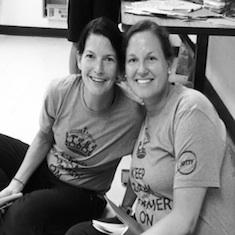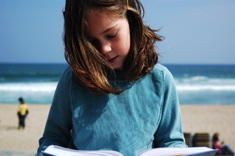One of our worst teacher nightmares is the way January can feel like September all over again. We love and look forward to the break in December just like anyone else, but it often feels like we’re hitting our groove right as the break arrives. Students are comfortable in our classroom routines, our class community has grown and we know one another well, and our students are becoming independent in their work—they seem brave in what they’re willing to try and confident in their articulation of what they’re trying when we pull up alongside them in conferences. One of the most visible differences in their work since September is their stamina when working.
By the time we get to the break in December, we’ve spent three months building stamina. In reading specifically, this has meant having our students set and reflect on reading goals daily, growing them gradually over days and weeks. By December, pretty much everyone’s reading stamina is at a place where we feel confident that they’re reading enough to grow themselves as readers. But then, the break arrives. We teach our students that just as taking a week or two off from running makes our first run after that time difficult, taking a week or two off from reading makes getting back into reading difficult.
We want our students to return in January ready to dig right back into their work, not having to spend time working to get back to where we were in December before the break. So, we spend some time a few days before the break talking up new books and making plans for winter break reading. Specifically, we make sure to
-
add new books,
-
give some book talks,
-
make tentative calendars,
-
prepare postcards, and
-
communicate with families.
New Books
Our district’s parent-teacher association has a generous library fund for each literacy teacher every year for the purpose of keeping our libraries stocked, current, and reflective of our new readers’ interests. We also use Scholastic in our classroom, and can’t help but spend our bonus points as soon as we have enough for a few texts. December is the perfect time to invest in new books for your classroom library, if only for the purpose of giving your readers new books they’re dying to read over the winter break.
Book Talks and Recommendations
We introduce new books that we bought for the classroom library, and also give students chances to talk up books to one another. Most of our students keep a list of books they’ve finished—either in their reader’s notebooks or on their filled reading logs and goal sheets. We ask them to look over their finished books and choose some they think their partner or book club would love (they know their partners and club members well by this point, after all, and know the types of books they tend to read), and then give them time to share a bit about the books. We also invite students to pass books to one another when they’re finished, and since our students keep “books on deck” in their book baggies (we’re super fancy and use giant zippered plastic bags hanging on hooks for book baggies in our room), they have a place to hold books they’re hoping to get to next. What better time than winter break to dive into some of the books they’ve been waiting to read?
Winter Break Reading Calendars
We first model how, and then give students time to create a tentative winter break plan. Emphasizing the tentativeness of the plan is important. We’ll use stories of our training for races—telling them that often just having a plan for our training helped us stay on track and do some running, even if we didn’t stick to the plan exactly. The point is to do some reading rather than no reading, not to follow the plan exactly. “The worst thing,” we’ll say, “would be to return in January and have reading feel harder than it is right now; your goal is for it to feel just as good as it does now or maybe even feel like a stronger reader. And the way for that to happen, we all know, is to carve out time for reading. Having a plan will make it more likely that you’ll have time for some reading, which means you’ll keep growing as a reader over winter break even though we’re not together.”
We model listing books that we’ve been saving on our nightstands for a time such as this, when we have no other work to do besides read for pleasure. We also map out when we’d like to start and finish each book on a calendar of our break, consulting our reading goal sheets and reading logs to help us estimate how long it tends to take us to get through books similar to the ones on our list. Part of our modeling, of course, includes thinking aloud about the different days over break, and how we may or may not have time to read on certain days because of what’s going on. (Some of us do nothing but read on Christmas, but others, for example, will be far too busy to pick their books up.)
This is the planning sheet we give students so they can make their tentative winter break reading plans.
We usually print the planning sheet on brightly colored paper so that it’s easily spotted, and then give students time in class to look through their book baggies and our class library and visit the school library to gather the books they hope to read. Students put their planning sheet and any books from school in a special zippered plastic baggie just for their winter break reading. They keep their baggies at their seat during reading workshop that day so that we can circulate and easily see who has an empty bag and might need some support finding some books during a small group or conference.
Having the students write where they’re going to find the book also helps, so that if their bag is empty but they have titles, they’re able to have a conversation about their plans to find the book; maybe it’s at home or at the town library. We keep the baggies in the room until the day before winter break, and then send them home so that they’re not lost in the normal weekday homework shuffle.
Postcards
Although we aren’t naive enough to think that all of our students are excited about the prospect of sending us a postcard about their reading over winter break, we know that a few will be really excited and motivated by it, and that’s enough for us. Before we send home the winter break book baggies, we add a postcard already addressed and stamped to one of us (since we coteach, we split the class down the middle so that we each might get postcards from half the class), and ask the students to send us a postcard at some point to tell us how their winter break reading is going. Any postcards we get we’ll display in our room so students can see what classmates read, and we always accept the trickle of postcards that come in once we’re back in January.
Communicating with Parents
Giving parents a heads-up about anything that we hope to happen at home is important, so we’re sure to send home an email or letter to let them know about the winter break book baggie that will be going home. Here’s the letter we used in 2016:
Our hope is that giving parents a heads-up that we’ve taken time to make winter break reading plans, as well as some of the thinking that went into why we made those plans, makes it less likely that the baggie will spend the entire winter break in the backpack, only to be discovered the night before we go back to school in January.
Although we believe that the unstructured time that a holiday gives our students is important, we also believe that reading is something that has to be done regularly for our students to grow as readers, and a long break from reading isn’t good for anyone. We’ve found success in devoting time specifically to talking about and planning for winter break reading in the days leading up to the break. And because the plans are tentative, they’re low stakes enough for students not to feel stressed about it as work to do over break, but maybe (we hope!) will be something to look forward to.






